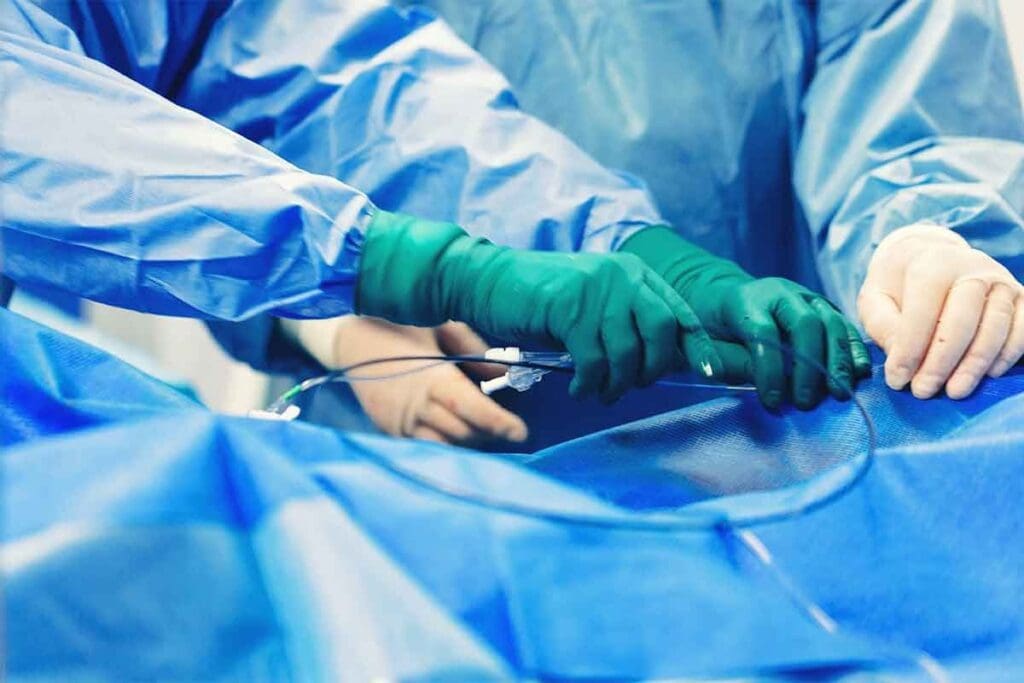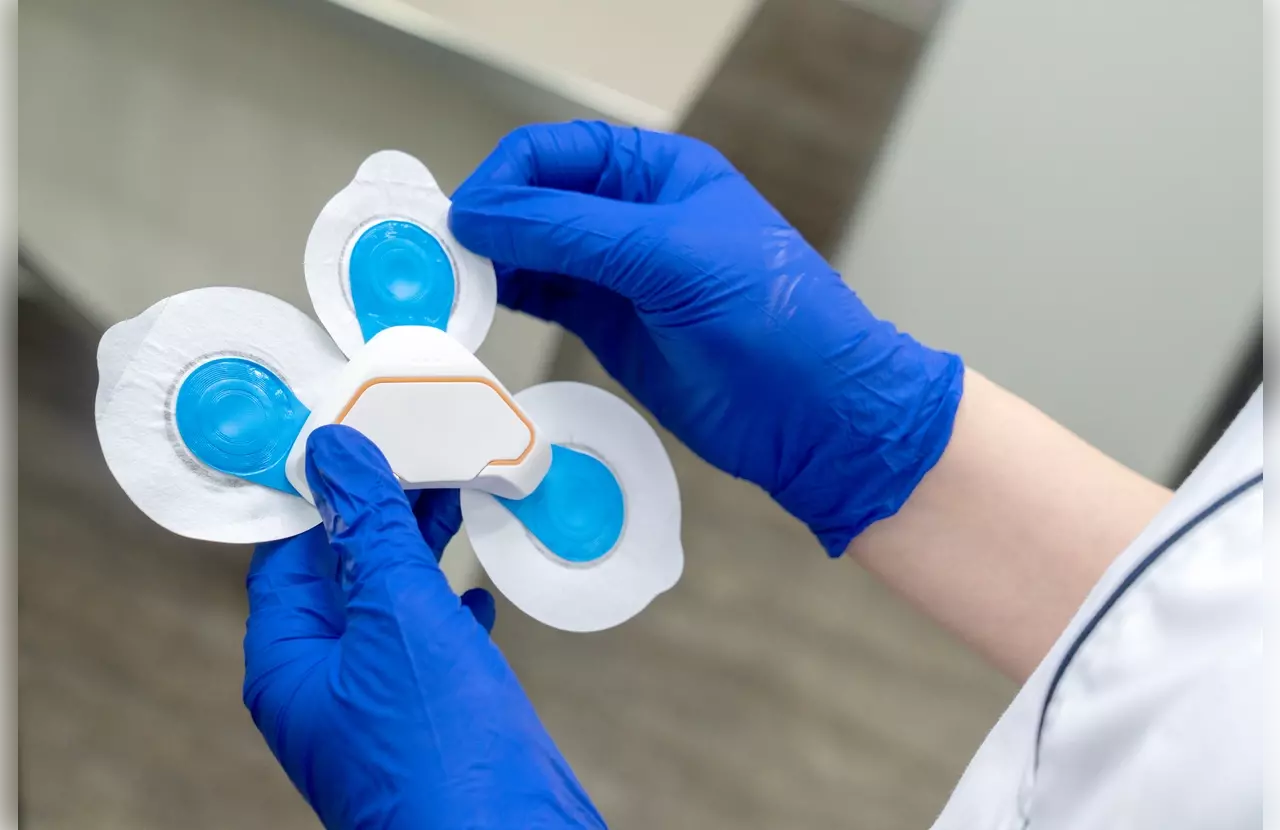Last Updated on November 26, 2025 by Bilal Hasdemir

If you have heart arrhythmias, knowing about new treatments is key. Radiofrequency ablation is a top choice when medications don’t work to fix heart rhythm problems.Learn how an ablation procedure treats heart arrhythmias and restores normal heartbeat.
Cardiac ablation is a small, non-invasive procedure. It makes scars to block bad electrical signals in the heart. This method has changed how we treat heart rhythm issues, giving patients a better life.
Key Takeaways
- Radiofrequency ablation is an effective treatment for heart arrhythmias.
- Cardiac ablation is a minimally invasive procedure.
- The procedure creates scars to stop irregular electrical impulses.
- It offers an alternative where medication fails to regulate heart rhythms.
- Patients benefit from advanced technology in treating heart rhythm disorders.
Understanding Heart Arrhythmias and Their Impact

It’s key to know about heart arrhythmias to find good treatments. These irregular heartbeats happen when the heart’s electrical system goes wrong. This can make the heart beat too fast, too slow, or in an odd pattern.
Arrhythmias can cause symptoms like palpitations, shortness of breath, and feeling tired. They can really change someone’s life, making everyday tasks hard and affecting their health.
Common Types of Heart Rhythm Disorders
There are many types of heart arrhythmias, each with its own signs and effects. Atrial fibrillation (AFib) is known for its fast and irregular heartbeats. Other types include atrial flutter, ventricular tachycardia, and supraventricular tachycardia.
About 6 million people in the U.S. have atrial fibrillation (AFib). This number is expected to double by 2030. This shows we need better ways to manage and treat these conditions.
How Arrhythmias Affect Quality of Life and Health
Arrhythmias can really mess with someone’s life, causing symptoms that can be mild or severe. They can also affect a person’s mind, leading to anxiety and depression.
These conditions also pose serious health risks. For example, AFib can raise the chance of stroke, heart failure, and other heart problems. Treatments like radiofrequency ablation can help by fixing the heart’s rhythm.
Understanding heart arrhythmias and their effects helps doctors create better treatment plans. This can lead to better health outcomes and a better quality of life for patients.
The Evolution of Ablation Procedures for Cardiac Treatment

Cardiac ablation has come a long way from being an experimental therapy to a common treatment for arrhythmias. This change is thanks to better medical technology and a deeper understanding of heart rhythm disorders.
Historical Development of Cardiac Ablation
The idea of cardiac ablation started in the early 1980s as a possible treatment for arrhythmias. At first, many were unsure about it. This was because there were no advanced mapping tools or catheter designs back then.
Key milestones in the development of cardiac ablation include:
- The introduction of radiofrequency energy for creating lesions
- Advances in catheter technology,alhave allowedor more precise navigation
- The development of 3D mapping systems to identify and target arrhythmia sources
From Experimental Therapy to Standard Treatment
As technology got better and more research came out, cardiac ablation became a widely accepted treatment. Now, catheter ablation for cardiac arrhythmias is seen as a safe and effective option. It’s used for many arrhythmias, like atrial fibrillation and ventricular tachycardia.
The move towards catheter ablation is because it’s less invasive. It’s done in special labs, which means patients recover faster and do better than with old surgical methods.
Factors contributing to the widespread adoption of cardiac ablation include:
- Increased understanding of arrhythmia mechanisms
- Technological advancements in catheter design and energy delivery systems
- Growing clinical evidence supports its efficacy and safety
Types of Cardiac Ablation Techniques
Cardiology has seen many new cardiac ablation techniques. These methods help treat heart rhythm disorders better. They offer patients many options based on their needs.
Radiofrequency Ablation (RFA): The Gold Standard
Radiofrequency ablation (RFA) is the top choice for treating heart issues. It uses electricity to heat a catheter tip, killing bad heart cells. It’s very good at fixing arrhythmias, like atrial fibrillation.
A study showed that 82% of patients with paroxysmal atrial fibrillation (AFib) stopped having symptoms after RFA. This shows RFA’s success in treating heart rhythm problems.
Cryoablation: Freezing Abnormal Pathways
Cryoablation freezes bad electrical pathways in the heart. It’s great for some arrhythmias, giving patients another option instead of RFA.
This method keeps the heart tissue safe while targeting the bad areas. It’s becoming more popular, giving patients and doctors more choices.
Laser and Ultrasound Ablation Options
Laser and ultrasound ablation are new ways to treat heart arrhythmias. They use different energy to kill bad heart tissue.
These technologies are growing, showing the constant innovation in cardiac ablation. They might offer new ways to treat heart issues.
| Ablation Technique | Energy Source | Primary Use |
| Radiofrequency Ablation (RFA) | Electrical current | Various arrhythmias, including AFib |
| Cryoablation | Cold energy | Specific arrhythmias, preserving tissue integrity |
| Laser Ablation | Laser energy | Emerging technology for arrhythmia treatment |
| Ultrasound Ablation | Ultrasound energy | Potential application in arrhythmia management |
Having many cardiac ablation techniques means doctors can tailor treatments better. This leads to better patient outcomes and a better life for those with heart arrhythmias.
How Radiofrequency Ablation Heart Arrhythmia Therapy Works
Radiofrequency ablation heart therapy uses RF energy to fix heart rhythm problems. It involves using a catheter to send RF energy to the heart tissue. This energy destroys the tissue, causing arrhythmia, helping the heart beat normally again.
The Science Behind RF Energy Delivery
The science of radiofrequency ablation is about delivering precise energy to the heart. The catheter’s tip sends out RF energy, creating heat. This heat kills the bad electrical pathways in the heart.
The energy delivery is watched closely to keep the temperature safe. It’s between 50°C to 60°C to protect healthy tissue. This careful approach is key to the success of ablation therapy for arrhythmias.
Precision Targeting of Problematic Cardiac Tissue
Precision targeting is a big part of radiofrequency ablation heart therapy. Advanced mapping helps find the exact problem area. Then, the catheter goes there, and RF energy is used to make lesions that stop the bad signals.
- Utilization of 3D electroanatomical mapping systems for precise localization.
- Real-time monitoring to adjust energy delivery as needed.
- Minimally invasive approach reducing recovery time.
Restoring Normal Heart Rhythm Patterns
The main goal of RF ablation heart therapy is to get the heart beating right again. By getting rid of the bad tissue, RFA helps the heart beat regularly. This makes life better for patients and lowers the risk of serious problems like stroke or heart failure.
After the treatment, patients are watched for any heart rhythm problems coming back. The treatment is a success if the heart rhythm goes back to normal. Ablation therapy for arrhythmias is a top choice for many because it works well.
What to Expect During an Ablation Procedure
Catheter ablation is a treatment for heart arrhythmias. Knowing what to expect can help a lot. The process includes several steps, from getting ready to recovering, and happens in special labs.
Pre-Procedure Evaluation and Preparation
Before the procedure, patients get checked thoroughly. This includes tests like echocardiograms and blood work. They might stop certain medicines and get a ride home.
On the day, patients get sedation and local anesthesia. This makes them comfortable and relaxed.
The Electrophysiology Lab Environment
The lab is equipped with the latest technology. It’s where heart rhythm disorders are treated. A team of experts works there, using X-ray images to guide the procedure.
Step-by-Step Process of Catheter Insertion and Navigation
The procedure starts with preparation and the application of sterile drapes. Small cuts are made to access veins. Sheaths and catheters are then guided to the heart.
Recovery Timeline and Post-Procedure Care
After the procedure, patients are watched for a few hours. Most go home the same day. Recovery time varies, but most can get back to normal in a week.
| Day | Activity Level | Care Instructions |
| 1-2 | Rest, avoid strenuous activities | Monitor insertion sites for signs of infection |
| 3-7 | Gradually increase activity level | Follow medication instructions, attend follow-up appointments |
| 7+ | Resume normal activities | Continue follow-up care as directed by your healthcare provider |
Knowing about the procedure can reduce anxiety. Following care instructions helps patients get the most from treatment.
Advanced Mapping Technologies in Radiofrequency Ablation Cardiology
Advanced mapping technologies are key in making cardiac radiofrequency ablation more precise and safe. They give detailed views of the heart’s electrical activity. This has changed radiofrequency ablation in cardiology a lot.
3D Electroanatomical Mapping Systems
Three-dimensional electroanatomical mapping systems are vital today. They make a detailed, three-dimensional map of the heart’s anatomy and electrical pathways. This helps doctors find and target abnormal electrical circuits with radiofrequency energy.
These systems have made RF catheter ablation more accurate. They give doctors a clear view of the heart’s complex structure. This makes navigating the heart easier.
Real-Time Monitoring for Precision and Safety
Real-time monitoring is a big part of advanced mapping in radiofrequency ablation cardiology. It lets doctors watch the heart’s electrical activity live. This means they can adjust the treatment as needed, keeping it safe and effective.
This live data helps doctors see how the treatment is working. They can make changes on the fly. This leads to better results and fewer complications.
Integration of Imaging Modalities
Using different imaging methods with electroanatomical mapping systems makes RF catheter ablation even better. For example, cardiac MRI or CT scans can be added to the 3D map. This gives a full picture of the heart’s anatomy and where the problems are.
This way of combining mapping and ablation has greatly improved radiofrequency ablation cardiology. It offers patients a safer and more effective treatment for heart arrhythmias.
Success Rates and Outcomes of RFA Cardiac Ablation
RFA cardiac ablation is a key treatment for heart arrhythmias. Its success rates have made it popular. The procedure works well for different heart rhythm disorders, but success rates vary.
Success Rates for Different Arrhythmia Types
The success of RFA cardiac ablation depends on the arrhythmia type. For example, SVT and atrial flutter have high success rates, over 90%. But treating atrial fibrillation is more challenging.
Atrial Fibrillation Success Rates
Atrial fibrillation treatment has seen big improvements with RFA. Success rates for this condition are between 75-80%.
“Catheter ablation is an effective treatment for atrial fibrillation, improving quality of life for many patients.”
— Dr. Hugh Calkins, Johns Hopkins Medicine
The 75-80% Success Rate for Atrial Fibrillation
The 75-80% success rate for atrial fibrillation ablation is a big achievement. It means many patients see a big drop in arrhythmia after treatment. But,success can depend on many factors, like the patient’s health and the arrhythmia’s duration.
Factors Affecting Treatment Outcomes
Many things can affect how well RFA cardiac ablation works. These include the arrhythmia type and duration, the patient’s age and health, and any heart conditions. Knowing these factors helps set realistic expectations and make better treatment choices.
Recurrence Rates and Management Strategies
ItArrhythmia can comeack after RFA. The chance of recurrence varies by arrhythmia type and other factors. For atrial fibrillation, recurrence rates can be 20-40% over time. To manage recurrence, treatments like repeat ablation, medication, or other interventions may be used.
| Arrhythmia Type | Success Rate | Recurrence Rate |
| Supraventricular Tachycardia (SVT) | 90% | 5-10% |
| Atrial Flutter | 85-90% | 10-15% |
| Atrial Fibrillation | 75-80% | 20-40% |
Understanding RFA cardiac ablation’s success rates and outcomes helps patients and doctors make better choices. The procedure has shown great promise, but research and improvements are ongoing.
Ideal Candidates for Cardiac Radiofrequency Ablation
Finding the right candidates for cardiac radiofrequency ablation is key to its success. This method works best for those with certain heart arrhythmias who haven’t seen results from other treatments.
Specific Arrhythmia Types Most Responsive to Ablation
Cardiac radiofrequency ablation is a top choice for treating atrial fibrillation, flutter, or supraventricular tachycardia. These conditions can really affect a person’s life quality. Ablation might be the cure they need.
- Atrial fibrillation: A common arrhythmia with irregular heartbeats.
- Atrial flutter: A fast heart rate caused by an arrhythmia.
- Supraventricular tachycardia: Abnormal heart electrical impulses.
When Medication Management Fails
When meds don’t work or cause bad side effects, radiofrequency ablation heart arrhythmia therapy is an option. This is true for those with arrhythmias that keep coming back.
Age, Health Status, and Other Considerations
Choosing catheter ablation for arrhythmia also looks at the patient’s age and health. Older patients or those with many health problems need careful checking to see if they can have the procedure.
Contraindications for the Procedure
Even though cardiac radiofrequency ablation is usually safe, there are times when it’s not right. These include:
- Active infection or sepsis.
- Significant bleeding disorders.
- Advanced heart failure.
Patients need to talk to their doctor about their situation. This helps figure out if radiofrequency ablation heart arrhythmia therapy is right for them.
Potential Risks and Complications of Radiofrequency Catheter Ablation
Radiofrequency catheter ablation is generally safe. But, like any invasive procedure, it comes with risks and complications. These can happen when treating cardiac arrhythmias.
Common Minor Complications
Minor issues can arise, such as:
- Bleeding or hematoma at the catheter insertion site
- Infection
- Pain or discomfort during or after the procedure
- Temporary arrhythmias
These problems are usually manageable with the right medical care.
Serious but Rare Adverse Events
Though rare, serious issues can occur, including:
- Cardiac tamponade (fluid accumulation in the sac around the heart)
- Stroke or transient ischemic attack
- Damage to the heart’s electrical system rrequiresa pacemaker
- Pulmonary vein stenosis
IPatients need to knowthese risks and talk about their individual risks with their doctor.
Risk Mitigation Strategies
To lower the risk of complications, several steps are taken:
- Careful patient selection and pre-procedure evaluation
- Use of advanced mapping technologies to guide the catheter
- Monitoring during and after the procedure
- Post-procedure care and follow-up
Comparing Risk Profiles Across Patient Groups
Risk profiles vary among different patient groups. The table below shows some key differences:
| Patient Group | Common Risks | Mitigation Strategies |
| Younger Patients (<50 years) | Lower risk of complications | Standard pre-procedure evaluation |
| Older Patients (>70 years) | Higher risk of bleeding, stroke | Careful anticoagulation management, closer monitoring |
| Patients with Comorbidities | Increased risk of infection, cardiac complications | Optimizing comorbid conditions before procedure, enhanced post-procedure care |
Knowing these differences is key to personalized care and making informed decisions.
Comparing Catheter Ablation for Cardiac Arrhythmias with Alternative Treatments
Cardiac arrhythmias have many treatment options. Catheter ablation is one, along with medication and surgery. It’s important to know how these treatments compare as medical tech improves.
Long-term Medication Management vs. Ablation
Medication is often the first choice for arrhythmias. But catheter ablation for arrhythmia might be a better option. It can keep the heart in rhythm better than meds for some patients.
For example, cardiac ablation can greatly reduce symptoms in atrial fibrillation patients. This is because it directly fixes the heart’s electrical issues. It might last longer than medication alone.
Surgical Approaches vs. Minimally Invasive Catheterization
Older surgical methods, like Maze surgery, are more invasive. Catheter ablation is less invasive, using catheters to fix heart issues.
Catheter ablation for arrhythmia has shorter recovery times and fewer risks. This makes it a good choice for many.
Cost-Effectiveness and Quality of Life Considerations
Cost and quality of life are key when choosing treatments. Catheter ablation might cost more upfront than meds. But it could save money in the long run.
Patients who get ablation therapy for arrhythmias often feel better. They have fewer symptoms and don’t need meds for as long. This can lead to a better life and lower healthcare costs over time.
Innovations and Future Directions in Ablation Therapy for Arrhythmias
The field of ablation therapy for arrhythmias is changing fast. New technologies and research are leading the way. These advancements aim to make ablation procedures more effective and safe.
Robotic Catheter Navigation Systems
Robotic catheter navigation systems are a big step forward. They offer better precision and control during procedures. This means doctors can target arrhythmias more accurately.
A study in a top cardiology journal found these systems cut down procedure times. They also improve results in complex cases.
“The use of robotics in electrophysiology labs is a breakthrough,” says a leading electrophysiologist. “It lets us work more precisely, which could lead to better results for patients.”
Advanced Mapping and Targeting Technologies
New mapping technologies are also key. 3D electroanatomical mapping and real-time monitoring help doctors see the heart’s electrical activity. This lets them pinpoint where abnormal rhythms are happening.
- High-resolution mapping systems
- Real-time data analysis
- Enhanced visualization of cardiac anatomy
Personalized Ablation Approaches
Personalization is becoming more important in ablation therapy. Tailoring procedures to each patient’s needs can lead to better results. Personalized ablation approaches use advanced imaging and mapping to create custom plans.
Combining Therapies for Enhanced Outcomes
Using different ablation techniques together is a new trend. For example, pulsed field ablation with traditional radiofrequency ablation might help some patients more. Research on these combinations is showing promising results.
Dr. [Last Name] believes the future of treating arrhythmias is combining different treatments. “This personalized approach is likely to greatly improve patient outcomes,” he says.
| Innovation | Description | Potential Benefit |
| Robotic Catheter Navigation | Precision control during ablation | Improved accuracy, reduced procedure time |
| Advanced Mapping Technologies | Detailed visualization of the heart’s electrical activity | Better identification of arrhythmogenic areas |
Conclusion: Making Informed Decisions About Heart Arrhythmia Treatment
Understanding heart arrhythmia and its treatments is key for patients. Cardiac arrhythmias can really affect your life. Ablation procedures are a good option for many.
Patients need to know the pros and cons of ablation. Talking to a doctor about your health and arrhythmia is a must. This helps decide the best treatment for you.
Thinking about the outcomes of an ablation helps patients make smart choices. As medical tech gets better, staying updated on treatments is important.
FAQ
What is radiofrequency ablation (RFA) for heart arrhythmia?
Radiofrequency ablation is a procedure that uses heat to fix heart problems. It destroys bad electrical paths in the heart that cause arrhythmias.
How does catheter ablation work for treating cardiac arrhythmias?
It starts with a small catheter going through a leg vein. Then, it’s guided to the heart. There, it uses energy to kill the bad tissue causing the arrhythmia.
What are the benefits of radiofrequency ablation in cardiology?
It’s very effective in treating some heart problems. It can make symptoms go away and improve life quality. Plus, it often has fewer side effects than long-term meds.
What types of heart arrhythmias can be treated with ablation?
Ablation can fix many heart rhythm issues. This includes atrial fibrillation, SVT, and VT.
How is radiofrequency energy delivered during RFA cardiac ablation?
The energy is sent through a catheter to the heart’s problem area. This allows for precise treatment of the bad tissue.
What are the possible risks and complications of radiofrequency catheter ablation?
Minor issues like bleeding or bruising can happen. But serious problems like cardiac tamponade or stroke are rare.
How do advanced mapping technologies improve the precision and safety of RFA?
New mapping tools, like 3D electroanatomical mapping, help track and target the bad tissue. This makes the procedure safer and more effective.
What is the success rate of RFA for atrial fibrillation?
RFA’s success rate for atrial fibrillation is about 75-80%. It works well for the right candidates.
Who are ideal candidates for cardiac radiofrequency ablation?
The best candidates have specific arrhythmias that respond well to ablation. They should have tried meds without success and mmetcertain health criteria.
How does catheter ablation compare to long-term medication management for arrhythmias?
Ablation can be a more lasting solution for some arrhythmias. It might cut down or eliminate the need for long-term meds and their side effects.
What are the future directions in ablation therapy for arrhythmias?
Future advancements include better robotic tools, advanced mapping, and personalized treatments. These will likely lead to better results and treat more arrhythmias.
What should I consider when deciding on treatment for my heart arrhythmia?
Think about your arrhythmia type and severity, your health, and the benefits and risks of treatments. This includes ablation and medication options.
References
Kornej, J., Börschel, C. S., Benjamin, E. J., & Schnabel, R. B. (2020). Epidemiology of atrial fibrillation in the 21st century: novel methods and new insights. Circulation Research, 127(1), 4–20. https://www.ncbi.nlm.nih.gov/pmc/articles/PMC7326495/






